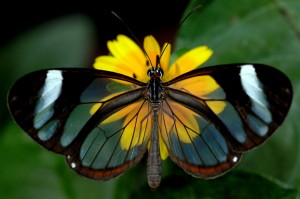Hi, I’m Dominic. I study biodiversity in tropical rainforests and tropical savannah of Guyana. Guyana is a little country next to Venezuela and above Brazil.
Anyone spending time in these forests or savannahs would quickly become familiar with the living space of Guyana.

The immense sky holds up the clouds that fill the rivers and lakes, the plumbing in the land of many waters. The rock and earth give the ecosystem its foundation; without which the trees could not grow. The tree trunks are the walls that hold up the roof of the forest, the canopy.

With a foundation, walls, roof and even plumbing, the structure of the rainforest is mighty impressive. It should be. Its home to countless plants, reptiles, mammals, and invertebrates.
Tropical rainforests host the most diverse array of animals of any terrestrial ecosystem. Seen here: long-horned grasshopper, Tamandua, and Cook’s Tree Boa. Image credits: Dominic Evangelista, Oswin Ambrose, Joseph Evangelista.
But for the most part, everything walks directly on the foundation of the forest. The forest has no floor. Despite the dense vegetation there is only a thin layer of dead leaves on the ground.

Who is responsible for cleaning up after the trees and animals? They are called detritivores-the housekeepers of the rainforest. Detritivores eat detritus, dead stuff. And they are just as important to the ecosystem as pollinating butterflies or arboreal ants.
What if there were no detritivores? What would the forest look like? Would there even be a forest?
Tropical rainforests are supremely efficient. The panoply of species all have very specific ways of doing business. Because of this, there is very little room for free energy. In other words, if there is lazy energy lying around someone isn’t going to eat. The energy has to be cycling through the system at all times. Bacteria need to be fixing nitrogen, plants need to be sucking up phosphorus, and carbon needs to be transferred at precise moments. If that carbon gets locked up somewhere then some bird, grasshopper, or bot fly won’t be able to eat. The bird needs the carbon from its insect prey. The grasshopper needs the carbon from green leaves. The bot fly needs its carbon from the flesh of a mammal.

So, what if there were no detritivores? The leaves that fall from trees have vital carbon, nitrogen and phosphorus molecules in them. Without the millipedes, isopods, crickets and cockroaches all that lazy energy would cause the entire system to collapse, and boom, we no longer have our wonderfully efficient tropical rain forest.
Leaves would pile meters high and the forest floor would take over. Young plants could not grow because the soil would be too leafy and not soily enough. Ground foraging birds would starve because there would be no juicy, fatty, cockroaches to eat.
But let’s get back to reality. Detritivores are there, and they do their job supremely well. So well, in fact, they nearly completely clean the forest of its leafy carpeting. They clean the floor down to the foundation.
You might think that being a detritivore is easy business. Well you’re wrong! There are 95 species of cockroaches known from Guyana alone. Each of these 95 do their detrivoring slightly differently. Not only that but they take their job seriously. It’s life or death you know.
An ecosystem is like an economy, it only works if resources are being constantly being transferred among its constituent parts. This means everything has to eat and also that those same things have to be eaten. That is the law of ecosystem survival, and it applies for everything in that ecosystem, even the dead-stuff.
About the author of this post: Dominic Evangelista is a PhD student at Rutgers University Newark researching cockroach biodiversity in the Guiana Shield. Follow him on twitter @Roach_Brain and see more about his research here.


